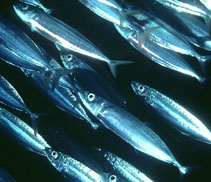| Family: |
Carangidae (Jacks and pompanos), subfamily: Caranginae |
| Max. size: |
46 cm TL (male/unsexed) |
| Environment: |
pelagic-oceanic; marine; depth range 0 - 400 m |
| Distribution: |
Circumglobal. Western Atlantic: Nova Scotia, Canada and Bermuda to approximately Rio de Janeiro, Brazil (Ref. 57756). Appears to be absent from the Gulf of Mexico (Ref. 9626). Eastern Atlantic: St. Helena, Ascension, Cape Verde, and Gulf of Guinea (Ref. 7097); Azores and Madeira (Ref. 4233). Indian Ocean: Red Sea, Gulf of Aden, Seychelles, Mascarenes, South Africa, and Sri Lanka (Ref. 3287). Eastern Pacific: Gulf of California and Revillagigedo Island to Ecuador (Ref. 9283). |
| Diagnosis: |
Dorsal spines (total): 9-9; Dorsal soft rays (total): 31-37; Anal spines: 3-3; Anal soft rays: 27-31; Vertebrae: 24-24. This species is distinguished by the following characters: oral valve (membrane) at symphysis of upper jaw conspicuously white in adults; posterior end of upper jaw straight above, moderately rounded and noticeably slanted anteroventrally; both jaws without teeth; shoulder girdle (cleithrum) margin with 2 small papillae, the lower papilla larger; terminal dorsal- and anal-fin rays each consisting of a widely detached finlet; pectoral fins short (58 to 72% of head length), tip of appressed fins falling considerably short of a vertical line from second dorsal-fin origin; lateral line scales, curved 58-75 and without scutes, straight 18-39 with 24-40 scutes, the total scales and scutes in lateral line (excluding scales on caudal fin) 110 to 138; interorbital scales usually extending to above front margin of the pupil. Colour in life bluish green and slivery below; small black blotch on margin of opercle near upper edge; caudal fin yellow-green and dorsal fin lobe sometimes dark distally; anal and pelvic fins pale to whitish (Ref. 9894, 11228). |
| Biology: |
Adults prefer clear oceanic waters, frequently around islands (Ref. 5217). Sometimes they are found near the surface, but generally caught between 40 and 200 m depth (Ref. 9283). Pelagic (Ref. 58302). Usually seen as fast moving schools along the reef edges near deep water (Ref. 48635, 26235). They feed mainly on zooplankton (Ref. 9283). Eggs are pelagic (Ref. 4233). Caught with purse seines and trawls (Ref. 9894). Marketed fresh and salted or dried (Ref. 9283). |
| IUCN Red List Status: |
Least Concern (LC); Date assessed: 20 August 2012 Ref. (130435)
|
| Threat to humans: |
reports of ciguatera poisoning |
Source and more info: www.fishbase.org. For personal, classroom, and other internal use only. Not for publication.

